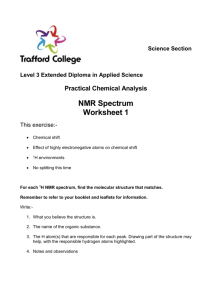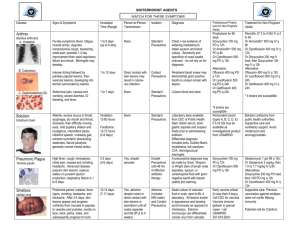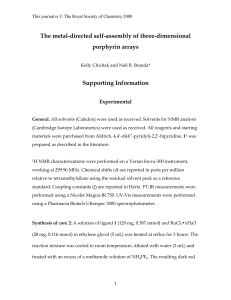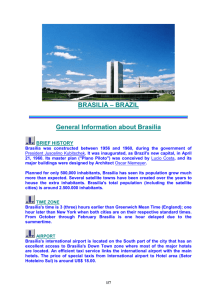POLA_23685_sm_suppinfo
advertisement
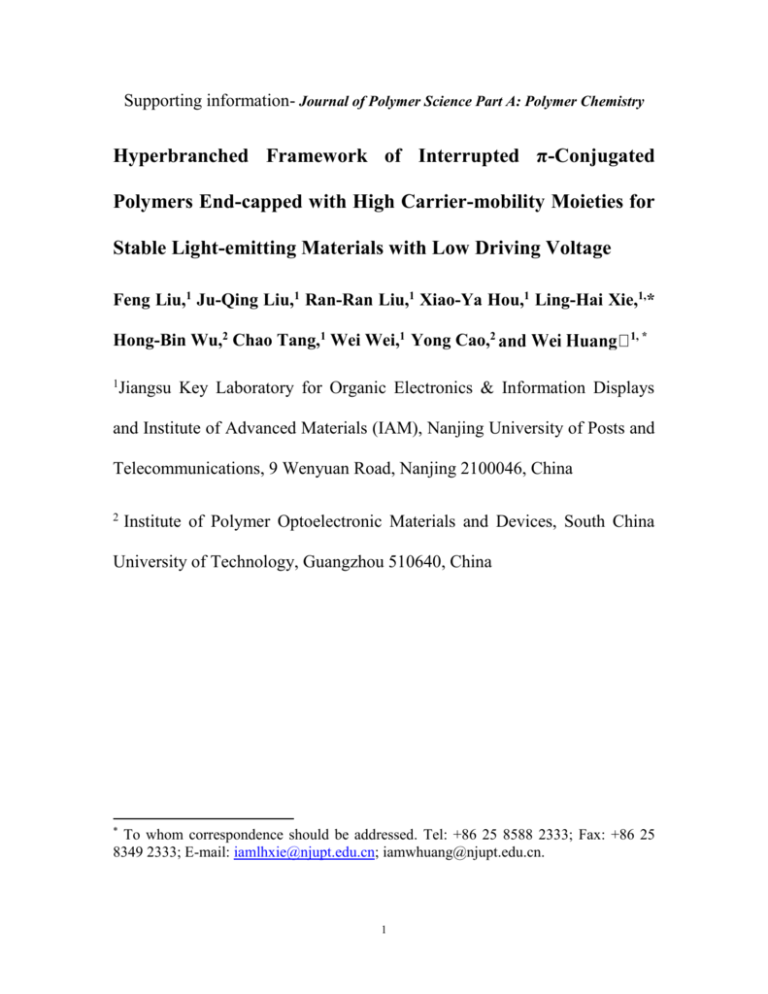
Supporting information- Journal of Polymer Science Part A: Polymer Chemistry Hyperbranched Framework of Interrupted π-Conjugated Polymers End-capped with High Carrier-mobility Moieties for Stable Light-emitting Materials with Low Driving Voltage Feng Liu,1 Ju-Qing Liu,1 Ran-Ran Liu,1 Xiao-Ya Hou,1 Ling-Hai Xie,1,* Hong-Bin Wu,2 Chao Tang,1 Wei Wei,1 Yong Cao,2 1 1, * Jiangsu Key Laboratory for Organic Electronics & Information Displays and Institute of Advanced Materials (IAM), Nanjing University of Posts and Telecommunications, 9 Wenyuan Road, Nanjing 2100046, China 2 Institute of Polymer Optoelectronic Materials and Devices, South China University of Technology, Guangzhou 510640, China * To whom correspondence should be addressed. Tel: +86 25 8588 2333; Fax: +86 25 8349 2333; E-mail: iamlhxie@njupt.edu.cn; iamwhuang@njupt.edu.cn. 1 Figure S1. The 1H-NMR spectrum of tris(4-(2-bromo-9-phenyl-fluoren-9yl)phenyl)amine. Figure S2.The 13C-NMR spectrum of tris(4-(2-bromo-9-phenyl-fluoren-9yl)phenyl)amine. 2 14.299 22.832 24.155 29.454 30.270 31.162 Figure S4. The C13 NMR spectrum of CDAF1. 0.816 1.140 32.023 40.621 53.644 55.570 120.184 121.715 126.377 126.951 127.367 127.400 128.381 128.998 129.147 140.239 140.716 3 1.559 1.562 2.115 2.124 6.954 7.114 7.260 7.374 7.524 152.028 ppm (f1) 0 50 100 150 7.678 7.834 Figure S3. The H1 NMR spectrum of CDAF1. 0.50 0.00 1.00 1.50 2.00 2.50 3.00 3.50 4.00 4.50 5.00 5.50 6.00 6.50 7.00 7.50 8.00 9.00 8.50 ppm (t1) 14.307 22.838 24.154 29.459 Figure S6. The C13 NMR spectrum of CDAF2. 0.822 30.271 32.029 40.634 55.574 120.198 121.721 121.825 126.385 127.435 128.458 129.007 140.254 140.725 ppm (f1) 1.147 1.572 2.123 6.961 7.122 7.258 7.380 7.522 152.040 4 0.0 2.5 5.0 7.5 0 50 100 150 7.687 7.839 ppm (t1) Figure S5. The H1 NMR spectrum of CDAF2. 0.829 1.153 14.309 22.843 24.165 29.464 30.279 32.035 40.638 55.581 120.199 121.725 121.834 126.393 127.436 128.528 129.008 5 1.595 1.609 2.129 2.134 6.978 7.127 7.258 7.382 140.259 140.735 Figure S8. The C13 NMR spectrum of CDAF3. 0 50 100 150 7.497 7.693 7.846 7.865 152.043 ppm (f1) 0.0 1.0 2.0 3.0 4.0 5.0 6.0 7.0 8.0 9.0 ppm (t1) Figure S7. The H1 NMR spectrum of CDAF3. Figure S9. The MALDI-TOF-MS spectrum of CDAF2. We use MALDI-TOF-MS to analysis the hyperbranched polymers. For CDAF2, the linear mode mass spectrum is listed (Figure S9). In the mass spectrum, three series of peaks could be observed, and we assigned A, B, C to them. For each group, the adjacent two peaks show a mass difference near 777, that is the mass of bifluorene, the repeating unit in the polymer. The hyperbranched polymer composed of three major building blocks, the core, dialkylfluorene and pyrene. The mass difference between adjacent B and C peaks is 200.5, based on structure analysis and mass calculation; we believe this is the signals that indicate the difference between B and C is the lack of a pyrene unit. 6 a) CDAF1 unannealed 12h under N2 b) CDAF2 unannealed 12h under N2 1h in air 3h in air 6h in air 12h in air Intensity (a. u.) 1h in air 3h in air 6h in air 12h in air c) CDAF3 unannealed 12h under N2 CDAF1 unanealed CDAF2 unanealed CDAF3 unanealed CDAF1 12h in air CDAF2 12h in air CDAF3 12h in air d) 1h in air 3h in air 6h in air 12h in air 375 450 525 600 675 375 450 525 600 675 Wavelength (nm) Figure S10. PL spectra of polymer films annealed under nitrogen and in air with different time at 200 °C. a) CDAF1; b) CDAF2; c) CDAF3; d) comparison of the three polymers before annealing and annealed in air for 12 h. 7 Relative Intensity 20 mA 10 mA 5 mA 2 mA 350 400 450 500 550 600 Wavelength (nm) Figure S11. Normalized electroluminescent spectra of CDAF1 in the device: (a) ITO/PEDOT: PSS (50nm)/PVK (40nm)/ CDAF1 (70nm)/Ba (4nm)/Al (120nm); (b) ITO/PEDOT: PSS (50nm)/ MEHPPV (0.25%)/CDAF-co-F1 (70nm)/Ba (4nm)/Al (120nm). CIE 1931 x, y color coordinates of EL emission at different current are shown in the inset. 8







